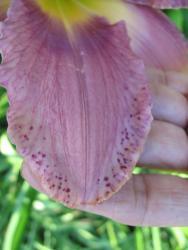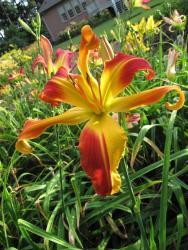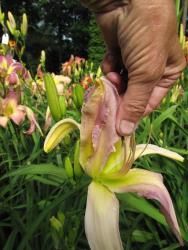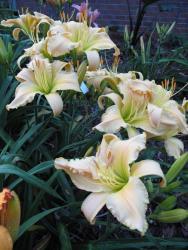Davi said:Could you comment on this again as it shows up in a lot of gardens. Isn't this likely to be caused by a weather event during bud formation?
Simple Answer:
Yes, it could be caused by a weather event during bud formation.
===
Every characteristic can be caused in one of three fundamental ways:
1) only genetically
2) only environmentally
3) through both genetic and environment interacting together.
Each time a flower has a split colour or one or more segments or sectors of a different colour we have to ask what caused it
this time.
Sometimes the answer will be that it is a one-off caused by an environmental effect during bud development, for example related to the weather.
Sometimes the answer will be that it is a one-off event caused by a genetic effect during bud development.
Sometimes the answer may be that it is a one-off event caused by a genetic effect that was itself caused by an environmental effect.
Each time it occurs investigating all the circumstances may help decide between several different possible answers as to the cause that time.
When I look at the sector in this particular flower I would start by asking do you know the plant's parentage? Is it possible that the plant has both a yellow-flowered daylily and a red-flowered daylily in its ancestry? I would ask, has this plant ever done this before? Is it a diploid or a tetraploid?
====
In this particular flower, as the flower develops in bud, the genes to make the red pigments (anthocyanins) have to be turned on in the petal. Most likely, once turned on in a cell all the descendants of that cell will have the gene turned on. If the gene is not turned on then all the descendants will have the gene turned off. Presumably there is a time during the development of the bud when there are only two cells that will be ancestors of all the cells in the upper layer (epidermis) of one petal. That layer has the anthocyanin pigments. A gene that is necessary to be able to make the red pigment must be turned on in both those cells so that both halves of that petal will be red. Something caused that gene to only be turned on in one cell or to be turned off after having been turned on in one of those two cells. That something could have been genetic or it could have been environmental (for example, the weather).
We may be able to get clues about whether the effect is genetically or environmentally caused. If the plant was from a long line of red x red crosses and the offspring from those crosses were reds then it is more likely that the effect was environmental. If the plant was from a cross of a red with a yellow and among its siblings there were both reds and yellows then there is a possibility that the effect is at least partly genetic. If the plant has done this before, or if some of the plant's siblings also sometimes show similar effects then there is a better possibility that at least part of the cause is genetic.
Sometimes it may be that both the environment and genetic effects must act together to cause the characteristic.
With our current knowledge of genetics in daylilies (lack of) it requires detective work and many assumptions, etc. to get some idea of what might be happening to cause the sectoring.






